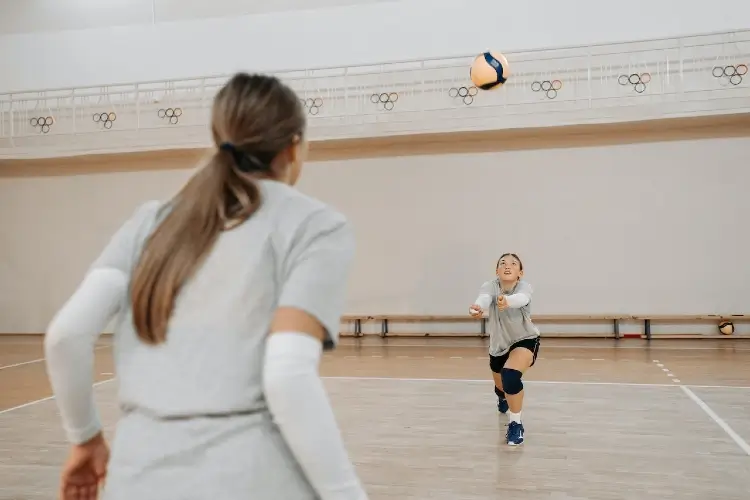Last Updated: January 12, 2024
It’s common knowledge that getting better at volleyball receiving can significantly enhance the chances of scoring, even under high-pressure game situations. After all, the teammates rely heavily on the receivers to proficiently receive the ball and pass it to a teammate to set the stage for numerous attacking options.
Handling serves and attacks from fierce opponents is not a walk in the park. Receivers must work on their skills to not only handle the opponent’s aggressive serving strategies but also to keep the team composed to increase the odds of scoring. A strong receiving team can really boost the team’s morale and offer a significant competitive advantage.
Here are some tips and drills to refine your volleyball receiving skills.
Tips for Improving Volleyball Receiving

Keep eye contact
In a fast-paced game like volleyball, it’s important to keep your eyes on the ball at all times to estimate its trajectory. To improve your receiving skills, you should also focus on keeping your eyes on the server’s hands when they connect with the ball. This will help you anticipate the strategy of the server.
It’s easy to get distracted and lose eye contact with the ball during high-pressure game situations. So, consciously focus on maintaining eye contact with the ball, even during long and intense practice sessions. This will prepare you to maintain eye focus when you step onto the court.
Don’t extend your knees fully
Bent knees lower the center of gravity, leading to better balance and stability. Therefore, it’s said to be the preferred stance for athletic performance. Maintaining a slight bend in the knees can also help you react quickly, ultimately improving your passing skills in volleyball.
The bent knee position will also work like a shock absorber, reducing the ball’s impact on your body. So, avoid the temptation to fully straighten your knees because this will limit your overall athletic performance.
Active footwork
When you move constantly, you can optimize your position for the opponent’s deceptive moves, making it difficult for the opponents to score points against your team. You will be able to change direction promptly, enabling you to cover the large court area sooner than usual.
Subsequently, you will be in the right position at the right time to receive and pass the ball. At the same time, this will convey a message that you are engaged and ready to compete at your highest potential.
Basically, active footwork will prepare you to respond better to the changing direction and speed of the ball.
Practice under pressure situations
A pressure situation mimicking the real game can really help in honing your volleyball receiving skills. To stimulate the real game situation, set specific goals and keep track of the scores during practice sessions.
You can also indulge in drills that can help you work under pressure. You might need a coach or teammate to help you with the drills.
Do conditioning exercises
When you are out of the court, do some conditioning exercises to keep you in great shape. Proper conditioning work can truly bring out the best athlete in you. A stronger and more resilient version of you is bound to perform better in the court.
So, work on your strength, power, endurance, and stability to build the necessary physical attributes required to always deliver a high level of performance. You should be able to endure long hours of practice sessions without any fuss.
Drills for Improving Volleyball Receiving
1. Off-Balance Drills
Off-balance drills can do wonders in improving your ability to receive the ball in non-ideal body positions during the game. Practice by having someone serve the ball to you. At the same time, ask your teammate or coach to push you gently in different directions.
This will force you to react quickly while regaining your balance to receive the serve accurately. Regular off-balance drills will make you far more agile and balanced than before, helping you achieve effective ball reception skills in the process.
2. Wall Pass Drills
If you cannot pair up with a partner to perform your drills, you can use a sturdy wall to perform the exercise. Start with feet shoulder-width apart stance, typically around 5-10 feet away from the wall, and toss the ball against the wall.
As the ball rebounds, position yourself to receive it and pass it back to the wall. Keep repeating the process of receiving and passing the ball by varying the intensity of the drill to keep things challenging.
3. High and Wide Passing
Good volleyball players can accurately pass balls that are not directly in their midline. This makes them better at receiving the ball because they can handle a wide variety of serves and attacks, even when the ball doesn’t come directly in the midline.
This drill involves getting a partner to serve the ball high and wide, at least above your waist level, and not in front of the body. Your job would be to get under the ball’s trajectory quickly. You will pivot the body to face the ball’s direction (right or left side) while keeping your forearm passing platform oriented towards the target (the setter).
So, you will not get behind the ball. The goal is to learn how to receive and return the ball when there is no time to get behind the ball. Using the ball’s natural rebound, you will redirect it over the other side of the net. You can ask your teammate to serve the ball from different angles to mimic real game situations.
4. Pepper Drill
Suitable for beginners and experienced players, this drill is typically done with a teammate. Ideally, your chosen teammate should be at the same skill level. You will stand around 10-15 feet apart from each other. Your teammate will initiate the drill by serving the ball. You will receive it and pass it back to him.
This will continue back and forth. The goal is to improve your receiving and passing. So, try to pass the ball accurately to your teammate. To make the drill more challenging, ask your teammate to serve the ball in different directions, such as to your left or right.
5. Serve Receive Drill
The Serve Receive drill will work on all aspects of your game. You will get better at both defense and offense because the drill requires you to receive the serve accurately, transition to offense, and set yourself up for an attack. This drill involves a whole team, though, or at least enough players to form two teams.
The serving team will occupy one side of the net, and the receiving team will occupy the other side. A player from one team will start the drill by serving the ball with the desired speed and placement.
The receiver’s team objective would be to pass the ball accurately to the setter positioned on the front row. The server will set the ball up for attack for one of the attacking players, who can then perform different types of hits.
The passing, setting, and attacking sequence will continue. The players can keep rotating so that everyone gets a chance to hone different skills. This drill can also be made challenging by targeting different areas of the court while serving (e.g., deep serves, short serves, etc.).
6. Passing Shuttle Drill
The passing shuffle drill can significantly improve one’s receiving skills and even passing techniques. The drill involves constant movement and proper footwork positioning to ensure accurate receiving and passing. To start the drill, the team will be divided into two lines.
So, instead of two players passing back and forth to each other from a stationary position, all the team players will be actively involved. The front-line server will pass the ball, shuffle to the right, and then move to the back of the line, creating space for the next one in line to receive and pass the ball.
This passing and shuffling sequence will continue as players rotate through both lines. After each pass, a player will continue to move to the right and join the back of the line so that the next player in the line can take charge.
7. Kneeling Receive
To improve low serves receiving skills, the ‘Kneeling Receive’ drill can be really effective. To initiate the drill, the server standing on the opposite side of the net will serve low shots. The person working on his volleyball receiving skills will kneel on both knees, 5-10 feet away from the server, and focus on receiving low serves.
Even in a kneeling position, the player must focus on receiving the ball accurately. Ideally, the knees should be close to each other, pointing toward the net. One can use power from their hips and legs to generate force for ball passing. This drill can be done for a set number of pre-decided repetitions.
Conclusion
A skilled receiving unit can foster a lot of confidence in the team. In a competitive match, where the room for receiving errors is very small, you can consistently provide good scoring opportunities and ultimately contribute to team success.
